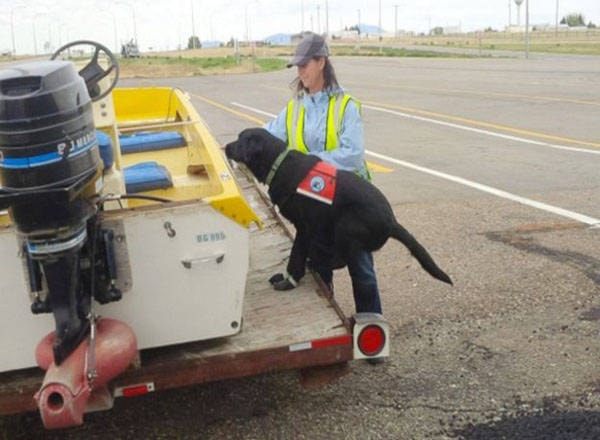Highly trained dogs may be the ultimate weapon to repel any potential invasive mussel outbreak from reaching the Okanagan.
Alberta’s K-9 conservation program has trained three mussel-sniffing canines to bolster inspection and decontamination stations across their province.
Since its inception in the spring of 2016, the K-9 program had one locally notable detection, discovering mussels on a boat passing through Alberta bound for Shuswap Lake that had been checked out previously at a Montana inspection station.
“These mussels can be the size of a sunflower seed at an early stage, so the human eye can’t always pick them up. For a dog, their sense of smell can pick up things that an inspector, through no fault of their own, might not catch,” said Cindy Sawchuk, the leader of Alberta’s K-9 program.
Sawchuk was recently in Penticton to participate in a public information forum on the invasive mussels and showcase her work partner Hilo, a Black Lab.
Hilo, along with his canine partners Seuss and Diesel and their handlers, have been trained through the Working Dogs for Conservation program in Montana.
It costs $25,000 to train a dog and their handler, which pales in comparison to the $75 million annual cost Sawchuk says is estimated Alberta would face to mitigate an invasive mussel infestation.
The province of B.C. announced in March it was training a dog to help sniff out mussels that will start July 1. Sawchuk acknowledged it took some convincing for her province’s fish and wildlife bosses to buy into the idea.
She said a pilot project enabled her to showcase how the sniffing capabilities of a dog can outperform the visual inspection capabilities of a human when inspecting a boat for mussel detection
“For the pilot project, we set up an accuracy and efficiency trial for the dogs up against mussel inspectors, and the dogs outperformed them in every category. In that trial, the dogs were 100 per cent accurate in finding mussels, humans were 75 per cent. And it took the dogs on average 2.3 minutes to find them, while it took humans well over five to six minutes,” she recalled.
That convincing evidence coupled with the media attention generated about the dogs has initiated support for the program from Alberta’s highest levels of government and helped raise public awareness of the mussel concerns.
Sawchuk said each of the dogs come from dog rescue outlets in the U.S., as detection dogs tend to be high energy and not very good domestic pets.
“Only about one in a 1,000 dogs have what it takes to make a good working dog. They have a high ball drive. They are obsessed with playing with a ball, and will do anything for the opportunity to play with that ball. That is their reward for what they are trained to do,” Sawchuk said.
“They are high energy and a high ability to remain focused on their task. That’s why they don’t make gold family pets. They need a job to do, a way to channel that energy.”
And dogs have an incredible ability to detect things through odour detection than people do, she added.
“I like to use the analogy of someone baking a cake in a house. When we walk in the front door, we might smell the cake cooking.
“For a dog, they can be a block and a half down the street from the house and they can smell all the different ingredients —the sugar the flower, baking soda, cocoa, the eggs—that have gone into making that cake.”
Sawchuk outlined a grave scenario of how invasive mussels can destructively impact a waterway from both economic and environmental perspectives.
She said the mussels are not native to North America, originally finding themselves relocated after being transferred from Eastern Europe in freighter ballast tanks.
“They reproduce rapidly, one single adult will have up to a million offspring each year, and nothing eats them. They destroy the food web and ecosystem that supports other fish, killing them off. Nothing keeps them in check,” she said.
Since their arrival, the mussels have made their way west across North America, with the northwest zone of Washington, Idaho and Montana, leaving B.C., Alberta and Saskatchewan to form a last-stand defensive alliance to prevent local waterways from being infected.
That alliance was shaken last December with the mussel detection in Montana, reinforcing the enormous challenge of detection and public education among boaters required to fend them off.
“In Alberta, we have thousands of miles of irrigation system buried pipes to move water to crops, and if the canals that feed them were infested with mussels, it would clog up the pipes,” she said.
“When I look around the beautiful vineyards in the Okanagan the rely on irrigation to keep the vines growing, what a massive, devastating impact that would be if the mussels reach here.”
She said a mussel invasion will spoil beaches with thousands of mussel shells that are sharp on the feet and generate a horrible stench. Lakefront property owners and beach-front hotels would see a massive impact on the value of their land and drop in tourism recreation attraction.
She cites mitigation numbers, both in theory and reality, that can be staggering to a province or state to absorb.
